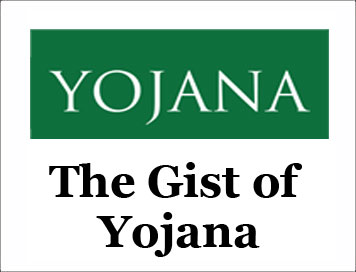
The Gist of Yojana: February 2017
Gist of The Yojana
Strengthening the S&T Roadmap
The Department of Science and Technology, Government of India
serves as the nodal agency for all government led initiatives that create and
strengthen the science and technology landscape in our country. The specific
mandate is to advance science and technology pursuits and develop related human
and institutional resources to foster excellence in these fields. The DST
accordingly develops policies and implements programmes to serve this important
mandate that also delivers science and technology based societal benefits. These
transformational changes are enabled through development models, stakeholder
engagement, internal connectivity of programmes, and coordination with several
other departments within our country and institutions outside through bilateral
and multilateral framer works.
The collaboration in Impacting Research Innovation and
Technology (IMPRINT) project entails DST's partnership with the Ministry of
Human Resource Development (MHRD) to address such major societal and
developmental needs as healthcare, information and communication technology,
energy, sustainable habitat, nano technology, water resources and river systems,
advanced materials, security and defence, and environment and climate change
related mitigation and adaptation.
Attracting Women to Science: This is achieved through
a programme titled KIRAN (Knowledge Involvement in. Research Advancement
through' Nurturing) launched in 2014. This enables gender parity in science
through nurturing research careers of women scientists. The programme provides
opportunities to women scientists who had a break in their career primarily due
to family responsibilities. The programme encourages them to take up research
and emerge as an entrepreneur if they so choose to.
Social benefits delivered: These cover a Wide variety
of sectors including energy benefits, wealth from waste and optimal extraction
and sustainable management of bio resources. Three such examples are presented
in the following.
Surya Jyoti lights up homes of poor: In order to
capture daylight and concentrate the same inside dark living spaces, a low cost
device named Surya Jyoti has been developed and tested. Surya Jyoti is basically
a Micro Solar Dome which has a transparent semi- spherical upper dome made of
acrylic material that captures sunlight. The light passes through a sun-tube of
a thin layer of highly reflective coating on the inner wall of the passage.
During daytime, illumination through Surya Jyoti goes upto, an equivalent of
15-watt LED lamp.
Indigenous technology for rural industrialization: For
inclusive development of the country, sustainable industrial activities using
local resources in the rural areas are extremely important. DST accordingly
endeavours to help rural populations through the application of science and
technology. One such initiative of the department has culminated in a
rural-industry complex in a plot of wasteland at Malunga, a village in Jodhpur
district of Rajasthan. Integration of technology in this industry complex has
been done in such a manner that it satisfies the local needs by utilization of
local resources. It offers sustainable and inclusive development by converting
waste to wealth.
Going Global through Mega Projects: The most important
guiding principle for this approach is to leverage India's excellence for
mutually reinforcing benefits for high end pursuits on frontiers. These in turn
enhance investigation and learning opportunities along with economic benefits
through enhanced industry activities.
Thirty Meter Telescope: India's Participation in
Thirty Meter Telescope (TMT) project at Mauna Kea, Hawaii, USA was approved by
the Government at a total cost of Rs.1299.8 crores in September 2014. The cost
would be met by DST and the Department of Atomic Energy. The other countries
participating in the project are USA, Canada, China and Japan. India will
contribute towards the construction phase, both in cash and kind. India will
benefit scientifically and technologically from participation in this project.
Associate Membership of CERN: The European
Organization for Nuclear Research (CERN) is the , world's largest nuclear and
particle physics laboratory, where scientists and engineers across the globe are
probing the fundamental structure of the Universe. Indian scientists have been
actively participating and collaborating at CERN on all aspects of science,
engineering and computing through joint funding provided by Department of Atomic
Energy (DAE) and Department of Science and Technology (DST). The CERN Council
admitted India as Associate Member of CERN in Sept. 2016. As an Associate Member
of CERN, India will be a part of the huge scientific and technological endeavor.
Laser Interferometer Gravitational Wave Observatory (LIGO):
India has agreed in-principle to set up an advanced gravitational-wave (GW)
observatory in the country; that will be the third such observatory across the
world. This will be a nationally coordinated project and three lead Indian
institutions, Inter-University Centre for Astronomy and Astrophysics (IUCAA),
Pune, Institute for Plasma Research (IPR), Gandhinagar and Raja Ramanna Centre
for Advanced Technology (RRCAT), Indore will steer this project in collaboration
with LIGO laboratories of California Institute of Technology (Caltech) and
Massachusetts Institute of Technology (MIT), USA.